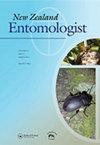温度对烧松长角天牛(鞘翅目:天牛科)卵发育和存活的影响
IF 0.4
4区 农林科学
Q4 ENTOMOLOGY
引用次数: 3
摘要
摘要:烧松长角甲虫,Arhopalus ferus (Mulsant)(天牛科:鞘翅目),是新西兰的一种引种物种,可以作为一种搭便车者与出口原木和锯材有关。它的生命周期在腐松中完成。测定了3 ~ 41℃14次恒温对烧松长角卵发育和存活的影响。通过线性模型和两个非线性模型估计,发育的低温极限分别为10.4°C、6.3°C和7.6°C。后两种估计可能比前一种估计更准确,因为在低温下发育曲线偏离线性。利用非线性模型估算出发育速率最大时的最佳发育温度为33.8℃和34.7℃。卵在10 - 38°C范围内孵化,持续时间从10°C的最长92天到35°C的最短4.3天。在13-32°C范围内存活率超过90%,在7°C和41°C时存活率为零。本文章由计算机程序翻译,如有差异,请以英文原文为准。
Effect of temperature on development and survival of burnt pine longhorn Arhopalus ferus (Mulsant) (Coleoptera: Cerambycidae) eggs
ABSTRACT The burnt pine longhorn beetle, Arhopalus ferus (Mulsant) (Cerambycidae: Coleoptera), is an introduced species in New Zealand that can occur as a hitch-hiker in association with export logs and sawn timber. Its life cycle is completed in decaying pine. We determined the effect of 14 constant temperatures from 3 to 41 °C on the development and survival of burnt pine longhorn eggs. The lower temperature limit for development was estimated to be 10.4 °C, 6.3 °C and 7.6 °C by a linear model and two non-linear models, respectively. The latter two estimates may be more accurate than the former as the development curve deviates from linearity at low temperatures. The optimum temperature for development, when development rate is at a maximum, was estimated by the non-linear models as 33.8 °C and 34.7 °C. Eggs hatched within the range 10–38 °C with duration ranging from a maximum of 92 days at 10 °C to a minimum of 4.3 days at 35 °C. Survival exceeded 90% in the range 13–32 °C and declined to zero at 7 °C and 41 °C.
求助全文
通过发布文献求助,成功后即可免费获取论文全文。
去求助
来源期刊

New Zealand Entomologist
ENTOMOLOGY-
CiteScore
0.70
自引率
33.30%
发文量
3
审稿时长
>12 weeks
期刊介绍:
The invertebrate diversity of New Zealand is of great interest worldwide because of its geographic isolation and geological history. The New Zealand Entomologist plays an important role in disseminating information on field-based, experimental, and theoretical research.
The New Zealand Entomologist publishes original research papers, review papers and short communications. We welcome submissions in all aspects of science regarding insects and arthropods in a New Zealand or Australasian setting. The journal’s subject matter encompasses taxonomy, phylogenetics, biogeography, biological control and pest management, conservation, ecology and natural history.
The journal is the official publication of the Entomological Society of New Zealand. Papers published or submitted elsewhere for publication will not be considered, but publication of an abstract or summary elsewhere (e.g. conference proceedings) does not preclude full publication in the New Zealand Entomologist. Accepted papers become copyright of the Entomological Society of New Zealand. The journal is published in English, but we also welcome publication of abstracts in Maori.
 求助内容:
求助内容: 应助结果提醒方式:
应助结果提醒方式:


